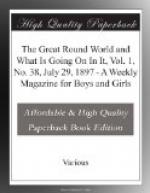* * * * *
=The great Round world
3 And 5 west 18th st. New York city=
* * * * *
A Good Agent
Wanted
In Every Town
for
“The Great Round World”
* * * * *
[Illustration: The great Round world and what is going on in it.]
Vol. 1 July 21, 1897. No. 38
England is preparing to send an expedition into the Soudan to reconquer the province of Dongola, which was lost during the revolt of the Mahdi in 1881-85.
Many of you have probably heard all about the Soudan war, in which the brave General Gordon lost his life. But that you may understand the matter fully, it will perhaps be as well to go over it again.
The Soudan is a vast tract of land in Africa, the boundaries of which are not very clearly defined. Roughly speaking, it extends from the Atlantic Ocean on the west to Abyssinia (King Menelik’s country) on the east; and from the desert of Sahara on the north, southward to the Guinea Coast and the Congo Basin.
Part of this country was owned by Egypt. If you look at the map you will see that Egypt borders on the Soudan.
The portion of the Soudan owned by Egypt comprised Lower and Upper Nubia, the White Nile region, and the territories around the Red Sea and the Gulf of Aden, Dongola being one of these Soudanese provinces.
Egypt is now a dependency of Turkey, and is ruled by a Khedive, who is a subject of the Sultan. Egypt pays a yearly tribute to Turkey.
In 1859 the building of the Suez Canal was begun. This canal extends across the Isthmus of Suez, and connects the Mediterranean Sea with the Red Sea, opening a waterway between Europe and Asia.
To accomplish the enormous task of building the canal it was necessary to have a great deal of money.
France subscribed one-half, and the Khedive of Egypt the other half.
But Egypt was not rich enough to advance such a large sum, so after a while the Khedive sold the shares he owned in the Suez Canal Company to the British Government, and the canal was then owned half by England and half by France.
Having such a heavy financial interest in the country (the cost of the canal was about one hundred million dollars), both England and France were anxious to have some control of the government of Egypt to prevent any legislation that might be hurtful to the development of their enterprise.
For some years England and France exercised a joint supervision over Egypt, but later it was arranged so that England assumed sole charge.
Much was done by England to develop the natural resources of the country, and all went well until the rebellion of the Mahdi in 1881.




